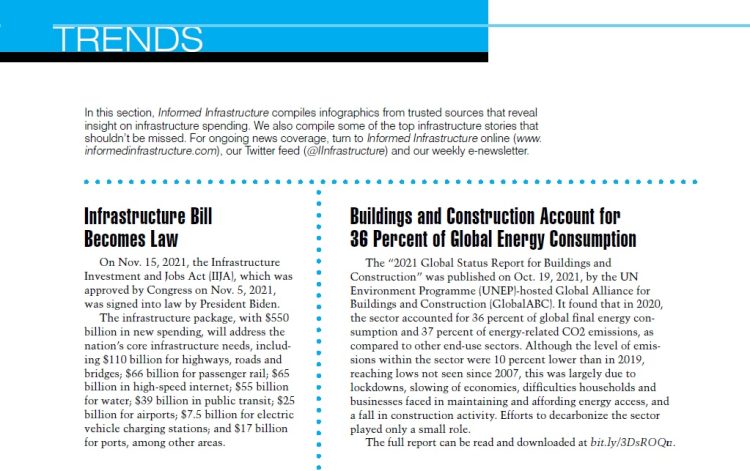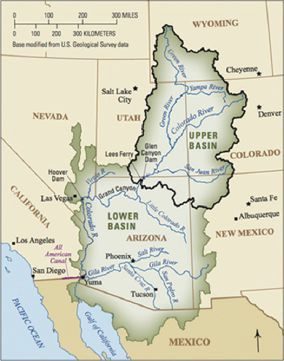December 2021 Trends

Infrastructure Bill Becomes Law
On Nov. 15, 2021, the Infrastructure Investment and Jobs Act (IIJA), which was approved by Congress on Nov. 5, 2021, was signed into law by President Biden.
The infrastructure package, with $550 billion in new spending, will address the nation’s core infrastructure needs, including $110 billion for highways, roads and bridges; $66 billion for passenger rail; $65 billion in high-speed internet; $55 billion for water; $39 billion in public transit; $25 billion for airports; $7.5 billion for electric vehicle charging stations; and $17 billion for ports, among other areas.
The “2021 Global Status Report for Buildings and Construction” was published on Oct. 19, 2021, by the UN Environment Programme (UNEP)-hosted Global Alliance for Buildings and Construction (GlobalABC). It found that in 2020, the sector accounted for 36 percent of global final energy consumption and 37 percent of energy-related CO2 emissions, as compared to other end-use sectors. Although the level of emissions within the sector were 10 percent lower than in 2019, reaching lows not seen since 2007, this was largely due to lockdowns, slowing of economies, difficulties households and businesses faced in maintaining and affording energy access, and a fall in construction activity. Efforts to decarbonize the sector played only a small role.
The full report can be read and downloaded at bit.ly/3DsROQu.
Groundwater Flow to Colorado River May Decline by a Third over Next 30 Years

USGS Public Domain
A new study (available at bit.ly/3FpuYtp) projects that a hot and dry future climate may lead to a 29-percent decline in Upper Colorado River Basin “baseflow” at the basin outlet by the 2050s, affecting both people and ecosystems.
Baseflow is the movement of groundwater into streams and, on average, accounts for more than 50 percent of annual streamflow in the Upper Colorado River Basin; it’s vital for sustaining flows in the Colorado River during dry periods. Scientists from the U.S. Geological Survey and the Bureau of Reclamation modeled temperature, precipitation and runoff data to understand more about how baseflow may change under three future climate scenarios.
Infrastructure on the Brink
The third national risk assessment from the nonprofit First Street Foundation, “Infrastructure on the Brink,” highlighted cities and counties across the continental United States whose residential properties, roads, commercial properties, critical infrastructure and social infrastructure face operational flood risk today, and how that risk is increasing during the next 30 years with a changing environment that will worsen the situation.
According to the report, about 2 million miles of road currently are at risk of becoming “impassable” due to flooding; nearly 1 million commercial properties, 17 percent of all social infrastructure facilities, and 12.4 million residential properties also have “operational risk”; and, during the next 30 years, about 1.2 million residential properties and 2,000 pieces of critical infrastructure (airports, hospitals, fire stations, hazardous waste sites and power plants) also will be at risk of becoming inoperable due to flooding from sea-level rise and/or heavy rainfall.
Access the full report at bit.ly/3Cvl3ke.
TOP Stories
The following are the top stories from the last few months (in terms of traffic) on the Informed Infrastructure website. This also reflects key coverage areas that are regularly refreshed online and via our weekly e-newsletter. Simply search key words on Informed Infrastructure online to find the full story.
Buildings
- SSSBA Releases Short Span Steel Bridge Technical Video Series
- Construction Sector Must ‘Clean Up Its Act’ on Decarbonization, Says Rocky Mountain Institute
- Sustainable New Concrete Mix from AEEE To Reduce Cement’s Global Carbon Footprint
- Stantec-Designed Covina Transit Center Opens to Public
- Simpson Strong-Tie Publishes Strong-Rod Design Guide for Engineering Mid-Rise Buildings to Resist Seismic and High-Wind Forces
Transportation
- North Atlantic Rail Proposal Wins Backing from 24 Members of Congress from CT, MA, ME, NH, NY, RI and VT
- Neste and Vitol Aviation Enable Heathrow to Become First UK Major Airport to Incorporate Sustainable Aviation Fuel into Operation
- Amtrak To Invest $7.3B In New Railroad Equipment
- Americans Riding Public Transportation in Greater Numbers
- Video: Rat Creek Slide Repair
Water
- Lack of Water Linked to 10 Percent of the Rise in Global Migration
- Podcast: Technology Adoption of Water Utilities
- Plan to Strengthen the Portland Metro Levee System Approved by the U.S. Army Corps of Engineers
- Smart Sewer Technology Satisfies EPA Consent Decree, Saves City $400 Million
- New ASCE Manual of Practice 145 Provides Guidance on Liner Design for Gravity Pipes
Tools and Technology
- InEight’s Fall 2021 Platform Innovations Double Down on Real-Time Capital Project Insights for Stronger Collaboration
- Idrica, Orange, Huawei Tests Connection of Millions of Devices Via 5G to Remotely Read Water Consumption In Real Time
- Over 350,000 Projects Turn to Autodesk Construction Cloud for Preconstruction Workflows
- Esri Releases ArcGIS GeoBIM, Bringing Spatial Context to AEC Operations
- Hexagon Adds England, Scotland and Wales to the HxGN Content Program


